About The Course Programming in Python CST 362 KTU

CST 362 PROGRAMMING IN PYTHON Category PEC L T P 2 1 0 Credit 3 Year of Introduction 2019 Preamble: The objective of the course is to equip the learners to develop multi-module software solutions for real world computational problems using Python. It encompasses the Python programming environment, syntax, data representations, intermediate level features, GUI programming, Object Oriented Programming and data processing. This course lays the foundation to develop modular software solutions including complex interactive applications, network applications, and data-driven intelligent applications. Prerequisite: Basic knowledge in Computational Problem Solving, A course in any programming language. Course Outcomes: After the completion of the course the student will be able to CO1:Write, test and debug Python programs (Cognitive Knowledge level: Apply) CO2: Illustrate uses of conditional (if, if-else and if-elif-else ) and iterative (while and for) statements in Python programs. (...
